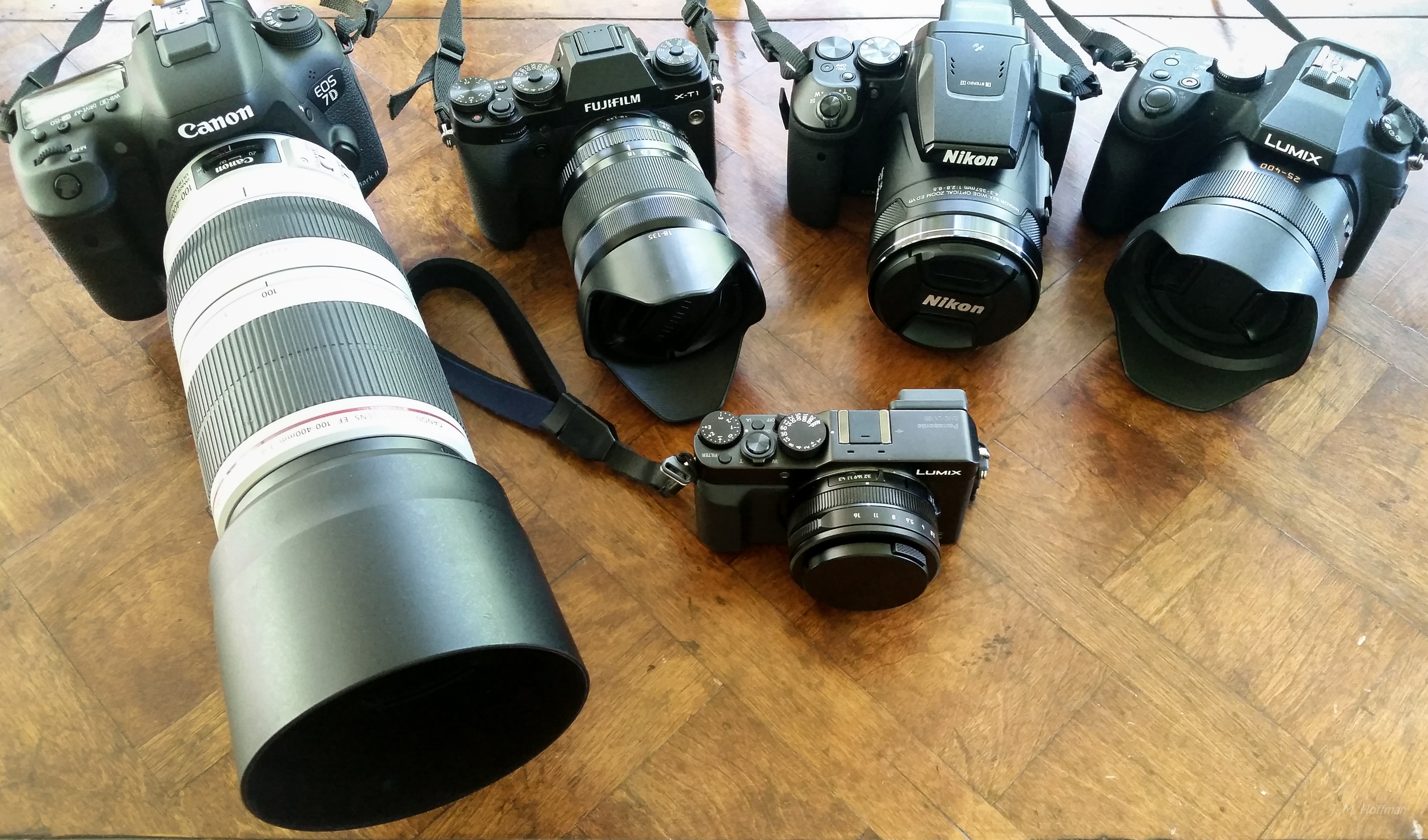While phone cameras do a great job, they still have significant limitations that can hold you back. So if you love photography, it won’t be long before you want to invest in something better. Here are five suggestions based on what you’re looking for.
1. I want to get closer to wildlife/birds/people/plants/etc.
So far, one of the biggest limitations of phone cameras is their reach. Even newer dual-lens cameras like the iPhone X or Samsung Galaxy Note 9 don’t let you zoom in on things that are far away. (You can use digital zoom, but — as you know if you’ve ever tried — the results don’t look very good.) So if you like photographing wildlife, or close-ups of people, or really anything that’s far away, you absolutely want to upgrade.
And the Panasonic Lumix FZ1000 is the ideal way to go. A wonderful all-in-one camera, the FZ1000 gives you great image quality and a zoom range equivalent to 25-400mm. (A “normal” view — what the eye sees, not zoomed in or zoomed it — is about 50mm. Most cell phones are about 27mm. The iPhone X zooms from 28-52mm. The FZ1000 gets you eight times closer than that.)
The perfect “Swiss army knife” of cameras, the FZ1000 also gives you a sophisticated video camera, full automatic operation when you want it, full manual control if you prefer, customizable buttons, raw files that offer additional creative possibilities, and more features than you’ll ever need. (While there’s an updated version of this camera, the FZ1000 “Mark II,” it’s more expensive and not worth the extra money for most people.)

The only real drawback is its electronic zoom — you have to push buttons to zoom in and out, instead of manually pulling or turning a lens — which can take longer than you want. But this is true of all cameras in its class. (If you want a manual zoom, though — and for wildlife you might — keep reading.)
2. I want to learn more about photography.
While phones take great pictures, they usually take the picture for you — and more and more, they use computer processing beyond your control to do it. So even though you can use your phone to learn more about photography, the phone will get in your way. This is when you want to invest in something else.
And the most economical way to get started is with an entry-level Nikon or Canon body and two lenses: a “kit” zoom lens and a 50mm prime lens. You really can’t do better than the Nikon D3500 with 18-55mm lens, which comes in under $400 new. Then add about $200 for Nikon’s 50mm f/1.8G lens and you’re set.
(You want the 50mm prime lens in addition to the zoom because the prime lens lets in much more light, giving you much better image quality and more creative possibilities. The only way to find out if you care about such things is to try it out.)
You have other choices, of course. The roughly equivalent path with Canon is the Rebel T6i with 18-55mm lens, but it will run you $600; on the other hand Canon’s 50mm lens is only $125. (There’s a T7i, too, but it’s significantly more money.)
Lots of other companies make good cameras, too, but the reason to choose Nikon or Canon is that those two main brands offer so many expansion options. You can almost always pick up inexpensive used equipment. You can rent pro lenses. (And a pro lens on any modern Nikon or Canon can give you pro results.) You can probably borrow equipment from members of a local photography club. You have third-party equipment options. And so forth.
Nikon and Canon make it easy to get started and won’t limit your options down the road.
3. I want better image quality.
Are you sure? “Image quality” can be misleading. It’s not just how good a photo is. It’s the technical quality of an image: how much detail it has and how accurate the colors are, for instance. For most people in most situations, a phone camera has enough image quality, so upgrading won’t usually make a big difference. But if you’re shooting in dark situations or making large prints or taking photos of things that move quickly, then you really do want better image quality.
To get that better image quality, the Nikon and Canon options above are one great way to go.
If you want even more image quality — and you very well might — consider Fuji’s mirrorless line. The Fuji X-T20 with 18-55mm lens will blow away the entry-level Canon and Nikon combos, to say nothing of your phone.
The reason to go with Fuji is their pricing model. To lure people away from Nikon and Canon, Fuji subsidizes their superb lenses when you buy one of their camera bodies, so you can get a pro-level lens at a discounted price.
Also, Fuji’s JPG files straight out of the camera are unsurpassed, so if you don’t want to process your photos after you take them, Fuji is a big win.
The two downsides are that Fuji doesn’t offer cheap, medium-grade equipment — forget about picking up a $125 50mm lens — and they’re still new to the consumer market, so you don’t have the breadth of options you get with Nikon or Canon. But if you’re looking for affordable quality, Fuji is the way to go.
(Even though they’re new to the consumer market, they are not new to photography. Fuji has deep expertise in photography and in pro-grade optics.)
4. I want to take pictures of things like athletes or animals that move quickly and are far away.
Sports and wildlife photography demand three things of a camera: quick response time, because things happen quickly; fast focusing, for the same reason; and long reach, because you’re usually not right next to the action. (Ignore this last point if for some reason you’re taking photos while you play sports.) And unless you’re shooting in bright sunlight, you have the additional challenge of getting enough light in your shot for a good image.
For these reasons, it’s not just phone cameras that limit your ability to take good wildlife and sports shots. The other options we’ve seen so far do as well. Of course it’s possible to get a good sports or wildlife photo with simple equipment; I got this photo of a woodpecker landing using a Canon setup you can buy used now for about $400:

But it’s much harder. So if you’re serious about sports and wildlife, you’ll probably want to spend about $3,500, as I describe here. A more economical route is the Nikon D3500 that we saw above with the Sigma 100-400 f/5-6.3 DG OS HSM Contemporary Lens, at a combined cost of about $1,100. You’ll still struggle when shooting indoors or on cloudy days (or at night), but you’ll be well on your way.
5. I want something I can keep in my pocket.
We all do, but if it were possible to make a pocketable camera with lots of zoom and good image quality, someone would have put such a thing on a phone by now. So if you decide you want a camera in your pocket, you’re going to have to sacrifice something.
The Panasonic DMC LX100 (with a mark II version now available) is pretty small and will give you much better image quality than your phone. It offers an equivalent zoom of 24-75mm, so you can get a bit closer to your subject than you can with your phone. And its controls make using it a joy. This is currently my go-everywhere camera. But it won’t quite fit in a pocket.

The Panasonic Lumix ZS200 is smaller and gives you a great zoom range, but the image quality, while still better than you phone, won’t match what you get from the slightly larger LX100 or the much larger FZ1000. Still, it’s small enough to take with you anywhere, and the quality is often good enough.
The Panasonic Lumix LX10 is like a compromise between the two. Its image quality is better than the ZS200 but not quite as good as the LX100, it’s smaller than the LX100, and its zoom range is 24-72mm.
(As a side note: Come on, Panasonic. Can’t you find a less confusing way to name your cameras?)
So take your pick. If you want the best image quality, go for the LX100 (original or more expensive mark II). If you want the smallest camera with the most zoom, the SZ200 is for you. If you don’t need that much zoom, get higher image quality with the LX10.










3 thoughts on “Buying Your First Real Camera: Five Suggestions Based on What You’re Looking For”